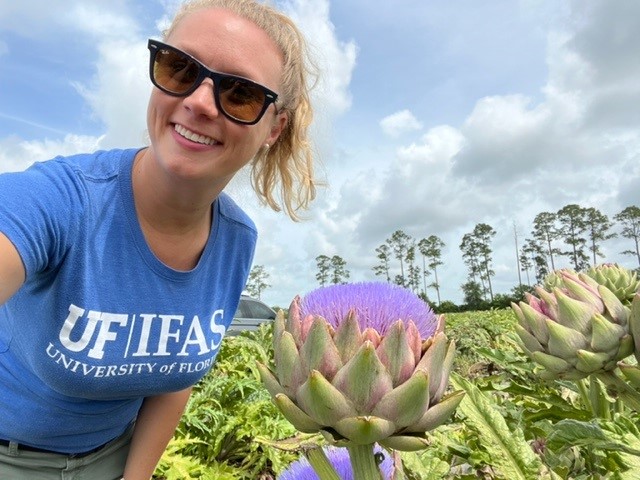Did you know you can plant artichokes in your garden or landscape as well as eat them? The artichokes you eat are, in fact, immature flower buds.

“Many home gardeners love artichokes, mostly as edibles,” said Shinsuke Agehara, a University of Florida (UF) associate professor of horticultural sciences who harvests the vegetable from January through March at the UF Institute of Food and Agricultural Sciences (IFAS) Gulf Coast Research and Education Center (GCREC). “But because their flowers are so pretty, I think many will try to keep some late buds to let them bloom in the field.”
Florida’s artichoke harvesting season lasts from January through May, depending on location.
Agehara recommends artichoke-growth practices for commercial growers and home gardeners.
Prissy Fletcher, a commercial vegetable production agent for UF/IFAS Extension St. Johns County, grows artichokes to eat and as cut flowers at the Hastings Agricultural Extension Center.
Producing artichokes in Florida can be tricky. To form buds, they generally require between 200 and 1,300 cumulative hours below 50 degrees Fahrenheit. But with gibberellic acid, a plant-growth hormone, it is possible to produce artichokes without relying on chill hours.
“We have to trick them into thinking they acquired chill because Florida does not provide sufficient hours of cooler temperatures,” Fletcher said.
California grows 99% of the nation’s artichokes, which flourish in a cool Mediterranean environment. But in 2017, UF started trying to grow artichokes at GCREC and at the Hastings center.
Agehara presented initial results at the Florida State Horticultural Society conference this year. The ‘Imperial Star’ and ‘Green Queen’ showed the most promise of growing in Florida’s warm, humid climate.
With help from gibberellic acid, ‘Imperial Star’ can produce as much as 15,420 pounds per acre, while ‘Green Queen’ can produce 10,485 pounds per acre, Agehara said. By comparison, California producers can grow up to 14,000 pounds per acre.
Over the last seven years, Agehara has researched additional varieties to identify the most suitable artichoke in Florida’s climate. In 2023, he selected eight hybrids out of 15 varieties, based on their yield.
UF/IFAS experts are also continually trying to get farmers to produce the vegetable.
Fletcher has travelled to a farmer’s market in St. Augustine for consumer research. Shoppers voted ‘Green Queen’ as their favorite artichoke.









